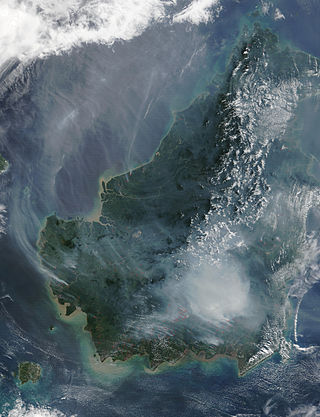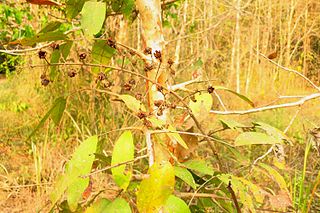
The otter civet is a semiaquatic viverrid native to Thailand, Malaysia, Indonesia and Brunei. It is listed as Endangered because of a serious ongoing population decline, estimated to be more than 50% over the past three generations, inferred from direct habitat destruction, and indirect inferred declines due to pollutants.

Peat swamp forests are tropical moist forests where waterlogged soil prevents dead leaves and wood from fully decomposing. Over time, this creates a thick layer of acidic peat. Large areas of these forests are being logged at high rates.

The dayak fruit bat or dyak fruit bat is a relatively rare frugivorous megabat species found only on the Sunda Shelf of southeast Asia, specifically the Malay Peninsula south of the Isthmus of Kra, and the islands of Borneo and Sumatra. There are three species in the genus Dyacopterus: D. spadiceus, D. brooksi and D. rickarti. All are found in the forests of Malaysia, Thailand, and the Philippines. Few specimens of any of the three species exist, due not only to their rarity, but also because they rarely enter the subcanopy of the forest where they can be caught in scientists' nets.

The Borneo peat swamp forests ecoregion, within the tropical and subtropical moist broadleaf forests biome, are on the island of Borneo, which is divided between Brunei, Indonesia and Malaysia.

Cratoxylum arborescens is a plant in the family Hypericaceae. The specific epithet arborescens is from the Latin meaning "tree-like".

Cratoxylum cochinchinense is a plant now placed in the family Hypericaceae. The specific epithet cochinchinense is from the Latin meaning "of Cochinchina". In Vietnamese C. cochinchinense is usually called thành ngạch nam or lành ngạnh nam, other names include: hoàng ngưu mộc, hoàng ngưu trà and đỏ ngọn.
Limnonectes kenepaiensis is a species of frog in the family Dicroglossidae. It is endemic to western Borneo and occurs in both Kalimantan (Indonesia) and Sarawak (Malaysia), and perhaps in Sabah (Malaysia). Common name Kenepai wart frog has been coined for it. It was first described as subspecies of Limnonectes paramacrodon, which it resembles.
Alangium havilandii is a tree in the dogwood family Cornaceae. It is named for the British surgeon and naturalist George Darby Haviland.
Anisoptera marginata is a tree in the family Dipterocarpaceae. The specific epithet marginata means "bordered", referring to the leaf veins.
Brackenridgea palustris is a tree in the family Ochnaceae. The specific epithet palustris is from the Latin meaning "swampy", referring to the species' habitat.
Hopea pentanervia is a tree in the family Dipterocarpaceae, native to Borneo. The specific epithet pentanervia means "five-nerved", referring to the species' five pairs of leaf veins.
Dryobalanops rappa is a species of plant in the family Dipterocarpaceae. The species name is derived from Iban and refers to the species habitat. This species is endemic to Borneo. It is found in at least one protected areas, but is threatened elsewhere due to habitat loss, The IUCN has assessed the species as Endangered due to habitat damage by deforestation, mining, agriculture and fires.

The Borneo lowland rain forests is an ecoregion, within the tropical and subtropical moist broadleaf forests biome, of the large island of Borneo in Southeast Asia. It supports approximately 15,000 plant species, 380 bird species and several mammal species. The Borneo lowland rain forests is diminishing due to logging, hunting and conversion to commercial land use.
Pulchrana laterimaculata, also known as the side-spotted swamp frog, is a species of "true frog", family Ranidae. It is found on the Malay Peninsula from the southernmost Thailand through Malaysia to Singapore, in Sarawak in Borneo, and on the Natuna Besar island in the Indonesian part of the South China Sea.
Madhuca barbata is a plant in the family Sapotaceae. The specific epithet barbata means "bearded", referring to the sepals.
Madhuca brochidodroma is a plant in the family Sapotaceae. The specific epithet brochidodroma means "loop-veined", referring to the leaves.
Madhuca daemonica is a tree in the family Sapotaceae.
Syzygium leucoxylon is a species of plant in the family Myrtaceae, that grows in the tropical peat swamp forest of Sarawak and Kalimantan. The species was described in 1848 by botanist Pieter Willem Korthals from specimens found growing on the mountain Gunung Pamaton, in Borneo.
Anacolosa frutescens, also known as galo or galonut, is a plant in the family Olacaceae. The specific epithet frutescens is from the Latin frutex meaning "shrub". It produces edible fruits and nuts eaten in the Philippines.
Sundadanio margarition is a danionin in the family Cyprinidae. It is endemic to Sarawak, Malaysian Borneo, and known from the Rajang and Sarawak River drainages. It lives in coastal peat swamp forests.







